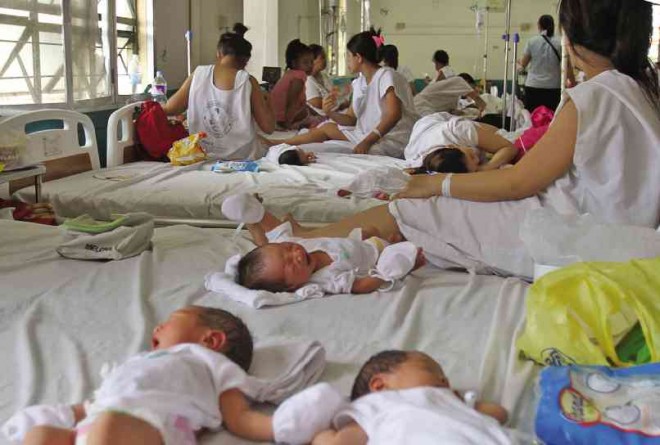
A MANILA hospital is overwhelmed by the number of women giving birth in a scene repeated many times over outside the metropolis, including the Ilocos region where one of every 10 mothers is a teenager. JOAN BONDOC
LINGAYEN, Pangasinan—The number of teenage mothers in the Ilocos region has risen over the past 10 years, alarming population officials who have raised concerns over the young child-bearers’ health.
The latest Young Adult Fertility and Sexuality (YAFS) study, by the University of the Philippines’ Population Institute (UPPI) and Demographic Research and Development Foundation, showed that at least one in every 10 girls, ages 15 to 19 years old, in the Ilocos region is already a mother.
“This is really a cause for concern in the region because the number of teenage mothers in the [Ilocos] has tripled in the last 10 years,” said Dr. Josefina Natividad, YAFS project coordinator.
Natividad, who presented the findings, said that in 2002, the proportion of girls ages 15 to 19 who became mothers was only 4.2 percent, but last year, it rose to 13 percent.
The findings were part of a nationwide survey on Filipino youth, ages 15 to 24, conducted in 2013. Some 1,000 respondents were from the provinces of Pangasinan, La Union, Ilocos Sur and Ilocos Norte.
“If you look at the breakdown by age, you’ll find that 1.3 percent of the 15-year-old [respondents] have begun bearing a child and the rise is very steep as you go older,” Natividad said.
“Why are we concerned about teenage fertility? It’s because we’re concerned about the health of the young woman,” she said.
“Her body is not yet prepared for the burden of childbearing. We’re also concerned about the child,” she added.
But Natividad said the teenage fertility rate in the Ilocos region was lower than that of other regions.
In the Cordillera, 18 percent of women in the same age range have begun childbearing, she said.
The “very high” proportion of women getting pregnant at a very young age, Natividad said, might be attributed to the youth’s increasing sexual activity despite the lack of knowledge on preventing pregnancy.
“For example, we asked during the survey if a woman can get pregnant after just one unprotected sex. In the Ilocos, only 62 percent agreed. The 38 percent who disagreed is a big number,” Natividad said.
The study also found that youth in the region started having sex at a younger age. The mean age for first sexual intercourse is 17.6 years old for males and 17.8 years old for females.
At least 23 percent of male youths and 23.7 percent of female youths in the region had sex before 18.
But Natividad said the proportion of those who had sex before 15 had decreased. In the Ilocos, she said, about 2.3 percent of boys and 1.3 percent of girls had sex before 15.
“Even then, sex before age 15 is really way too early,” Natividad said.
“The clincher there is that most of these risky sexual activities are unprotected against the risk of either pregnancy or sexually transmitted infection,” she said. Gabriel Cardinoza, Inquirer Northern Luzon